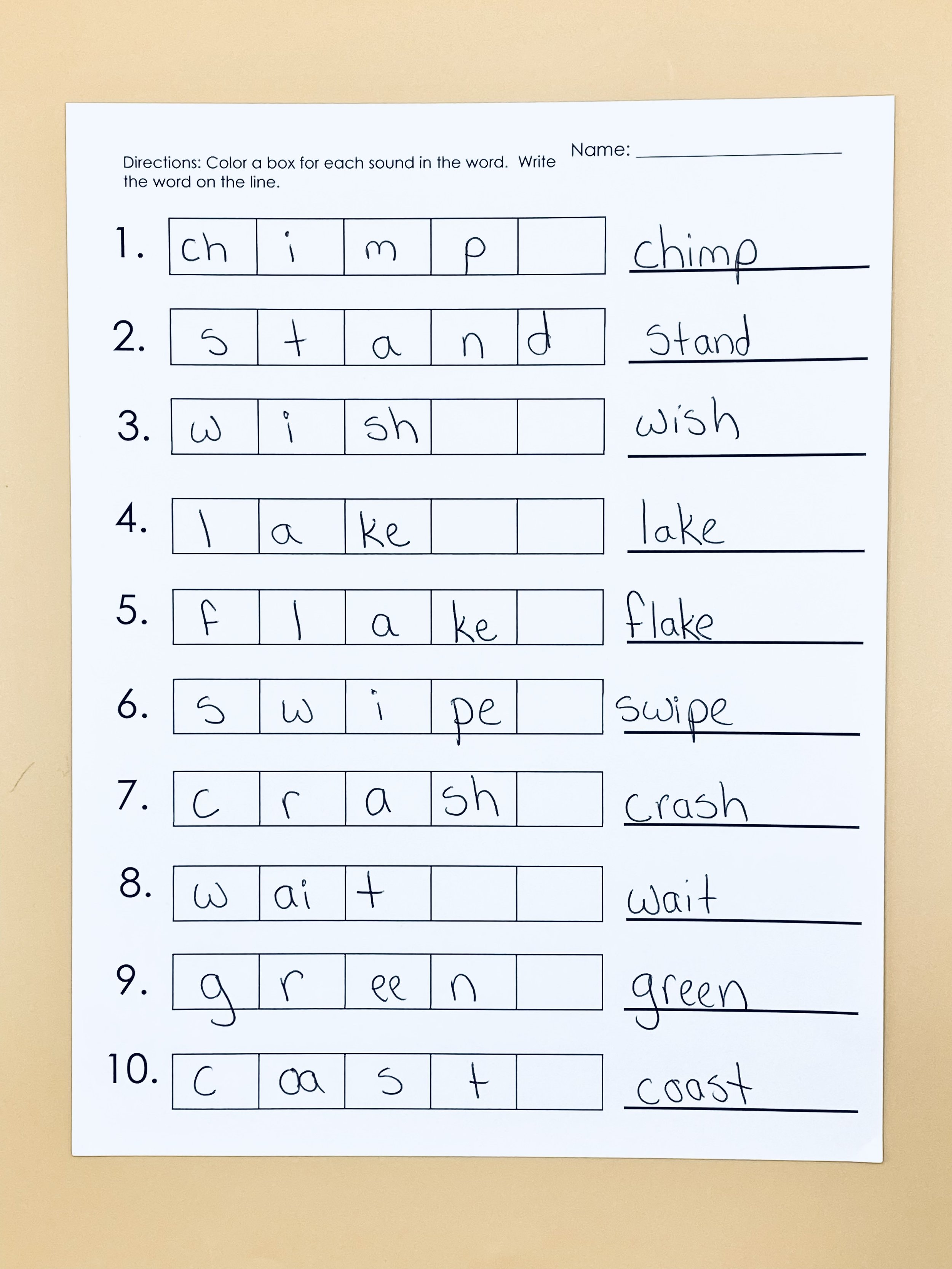
Share This:

Phonics is ubiquitous. You honestly can’t read an education article or listen to a podcast without hearing about the importance of phonics. But what does the research actually suggest concerning phonics instruction? I believe that knowledge is power, and today I want to give you key points about the effects of phonics instruction. Keep this post in mind for future meetings, professional development, or times when a colleague might question why phonics is so incredibly important.
There’s really two main types of phonics instruction: synthetic and embedded. In synthetic phonics, teachers move “from parts to whole. The parts are the small units of sounds (phonemes in words, represented by combinations of alphabetic letters)”(Stone, 2019, p.17). Essentially, synthetic phonics teaches students phonemes and the graphemes that represent those phonemes. They then use phoneme-grapheme correspondence to read words, sentences, and connected text. Teachers who use synthetic phonics use a scope and sequence to ensure that key skills are taught in a meaningful way where current skills build on previous ones.
Embedded phonics does teach phonics, but it is led by needs from a text. Let me explain. In embedded phonics instruction, teachers most often use leveled texts. A teacher uses the text to decide what phonics skills to teach. Instead of a scope and sequence leading the instruction, it is a book that leads the instruction. With this kind of phonics, there are often missing pieces because there is no clear sequence.
According to the NRP, the answer is clear! They state that findings “revealed that intensive training in phonics produced superior word reading skills compared to embedded phonics training or training given to control groups”(National Reading Panel, 2000, p.2-128). This is important because most programs will claim that they teach phonics. This is simply a ploy to sell more programs and make more money, though. The truth is that you cannot just sprinkle phonics here and there: it is the systematic, explicit phonics that makes the biggest impact.

Without a doubt, the sweet spot for teaching phonics is in kindergarten and first grade. Where the overall effect size for teaching phonics is .41 (a moderate effect), the effect size for kindergarten students at risk was .58, at-risk first graders was .74, and typically developing first graders was .48. This shows that phonics has a moderate effect size in kindergarten and first grade, with an even higher effect size for students who are at risk.
I will discuss older students shortly, but keep this in mind: it is critical that we get phonics instruction right in kindergarten and first grade. That gives our children the best opportunity to find success.
This is a multi-layered question that reiterates the importance of phonics instruction in kindergarten and first grade. For 2-6th grade typically achieving readers, the effect size was .27. For 2-6th grade students who were low achieving, the effect size was only .15. Those effect sizes are considered low and insignificant, respectively.
So what do we do, then? If our students are in 2nd grade and can’t read “cat,” does this mean that we don’t teach them phonics? Should we try whole-word teaching instead? Despite the very low effect size, we do not simply abandon best practices. If a student above 2nd grade cannot read cat, we must still meet them where they are. It will not be as easy, it will not be as fast, but the actual process of learning to read must still happen.

The National Reading Panel explains the potential reasons for the low effect sizes. They state, “Possible reasons might be that the phonics instruction provided to low-achieving readers was not sufficiently intense, that their reading difficulties arose from sources not treated by phonics instruction such as poor comprehension, or that there were too few cases… to yield reliable findings”(NRP, 2000, 2-133). This is an area that definitely needs some more research and focus!
Once again, though, the bottom line is this—we have to teach children how to read through explicit phonics instruction in kindergarten and first grade. Without a solid foundation, the achievement gap begins to grow wider and wider.
At first, I thought this was a ridiculous question—of course it doesn’t, right? In the beginning, word recognition and language comprehension are two different strands of the reading rope. It was such a humbling experience to eat that crow pie.
Turns out, phonics instruction DOES have a significant impact on comprehension in kindergarten and first grade. The effect size on comprehension in kindergarten and first grade is .51, which is a moderate effect size. Put simply, the ability to read the words directly influences your ability to comprehend the words.
In second through sixth grade, however, the impact of phonics on comprehension is not significant. The effect size was only .12. This makes sense, because as students grow older and texts become more complex, there are more factor involved in understanding (like background knowledge and vocabulary). So while the ability to read the words does not guarantee comprehension, the inability to read the words will guarantee they cannot comprehend the text.

This isn’t exactly the most glamorous section. But this is the section you can refer to when somebody says, “How can we even trust what they said?” By understanding the way the National Reading Panel conducted their meta-analysis, we can have more trust in their findings.
The phonics subgroup only looked at studies published after 1970. Each of the studies had to give synthetic phonics to one group, and unsystematic or no phonics to another group. Studies were excluded if they were included in their meta-analysis on phonemic awareness. All studies had to include reading measured as an outcome.
Originally, 75 studies appeared to meet their criteria, but 37 were eliminated. In their report, the NRP details why studies were excluded, as well as lists all of the excluded studies in the appendix. Reasons for exclusion included, among other reasons, inadequate statistics, inadequate outcome measures, and short-term studies. Of the remaining 38 studies, 28 were published in the 10 years leading up to the panel.
If I had to summarize this post in one sentence, it would be this: systematic, explicit phonics instruction is essential for our children learning to read. My key understandings from the National Reading Panel’s subgroup on phonics instruction are that synthetic phonics is the most effective, and it is most effective in kindergarten and first grade. When we don’t get it right in those grades, we start an achievement gap that becomes more and more difficult to remediate with every year the child doesn’t know how to read. If you (like me) happen to teach older students, do not despair. There is hope—we can still reach these children, but it will take longer and it will take the effort of all individuals involved in their education to make it work.
Works Cited:
National Reading Panel (U.S.) & National Institute of Child Health and Human Development (U.S.). (2000). Report of the National Reading Panel: Teaching children to read : an evidence-based assessment of the scientific research literature on reading and its implications for reading instruction. U.S. Dept. of Health and Human Services, Public Health Service, National Institutes of Health, National Institute of Child Health and Human Development.
Stone, L. (2018). Reading for Life: High Quality Literacy Instruction for All (1st ed.). Routledge.
Share This:

Savannah Campbell is a K-5 reading specialist. She has taught her entire 12-year teaching career at the school she went to as a child. She holds two master’s degrees in education from the College of William and Mary. Savannah is both Orton-Gillingham and LETRS trained. Her greatest hope in life is to allow all children to live the life they want by helping them to become literate individuals.

Savannah Campbell is a K-5 reading specialist. She has taught her entire 12-year teaching career at the school she went to as a child. She holds two master’s degrees in education from the College of William and Mary. Savannah is both Orton-Gillingham and LETRS trained. Her greatest hope in life is to allow all children to live the life they want by helping them to become literate individuals.
Feeling overwhelmed with all the terminology out there? Want to know the key terms all teachers need to teach phonics? In this FREE Rules of English cheat sheet, you get a 5 page pdf that takes you through the most important terms for understanding English—you’ll learn about digraphs, blends, syllable types, syllable divisions, and move. Grab today and take the stress out of your phonics prep!
